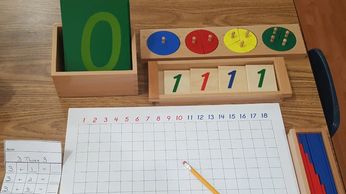"Never help a child with a task at which he feels he can succeed."
-Maria Montessori
Language

Spoken Word to the Written Word
The language curriculum progresses from oral language activities and pre-reading work to writing and ultimately to reading comprehension. The aims of the oral language activities include the development of listening skills, comprehension and vocabulary as well as the ability to express oneself with confidence. The materials for written language introduce children to the letters of the alphabet and their corresponding sounds. Children then go on to compose words and sentences using the moveable alphabet. All aspects of language development are occurring simultaneously and it is the teacher's role to observe readiness for each new lesson.
Math

Journeying from the Concrete to the Abstract
Lessons presented in the practical life and sensorial curriculum lay the groundwork for children to begin to explore the world of math. The concrete math materials enable the naturally mathematical mind of the preschool child to journey from the concrete to the abstract through manipulation and experimentation. Children first explore the concept of quantity or "how many". The Montessori materials build on each other in a natural progression, encouraging children to explore and discover. From there children move on to using symbols or written quantities and then begin to combine quantities for the operations of addition, subtraction, multiplication, and division.
Practical Life
The Skills of Daily Living
The practical life area of the curriculum is the bridge for young children between home and school. Practical life activities allow the young child to perform adult activities. The aims of the practical life materials are fostering independence, establishing a sense of order, and honing concentration and coordination. Practical life lessons include care of the person (buttoning, zipping, tying); care of the environment (cleaning, polishing, food preparation); small and gross motor development (pouring, cutting, balancing); and social development (interpersonal skills, grace and courtesy, speaking, participating in a group).
Sensorial
Social Studies and Science

Exploring the World through the Five Senses
Dr. Maria Montessori identified the period from 2-6 years as the age of the "absorbent mind". Children come to know and understand the world they live in through their five senses. The Montessori sensorial materials, such as the pink tower, geometric solids, sound cylinders and color tablets help children to understand and internalize the concepts of size, shape, color, taste, touch and sound. These materials build the foundation for developing skills in the areas of music, mathematics and language.
Social Studies and Science
Social Studies and Science
Social Studies and Science

Cultural and Science Activities
Geography and the sciences make up the cultural component of the preschool program. The geography curriculum introduces the concepts of land and water forms, the study of cultures and customs, and the understanding of fundamental human needs through exploration of the seven continents. The science curriculum is aimed at developing an awareness of science concepts through discovery and experimentation. Included within the curriculum are hands-on lessons in the areas of botany, zoology and physical science.
Now enrolling for school year 2025-2026
Welcome! If you have any questions please feel free to contact me. Thank you.